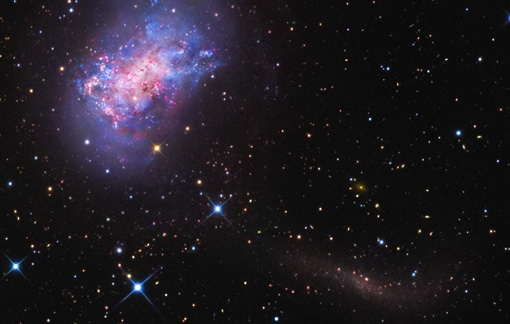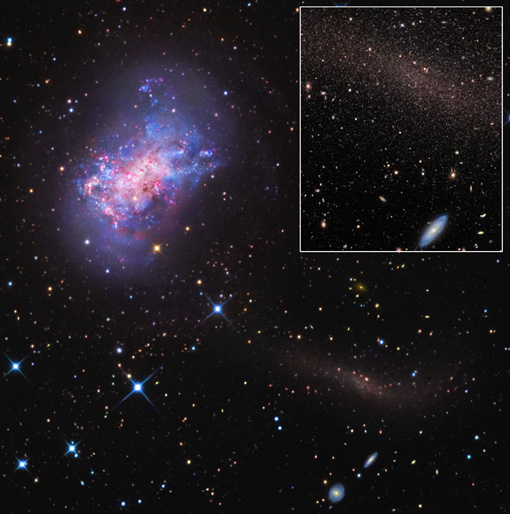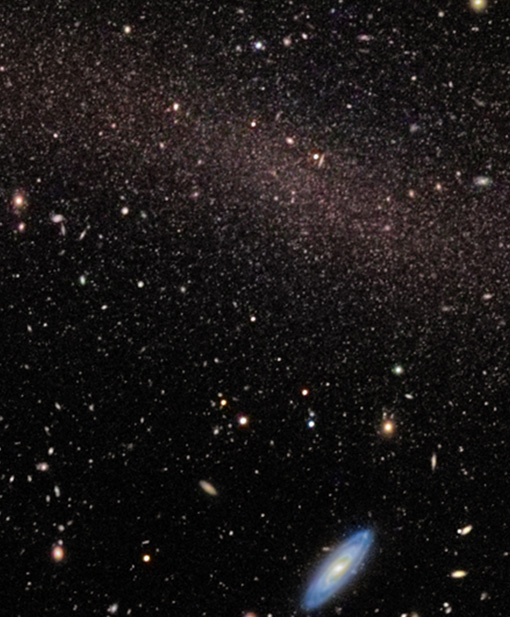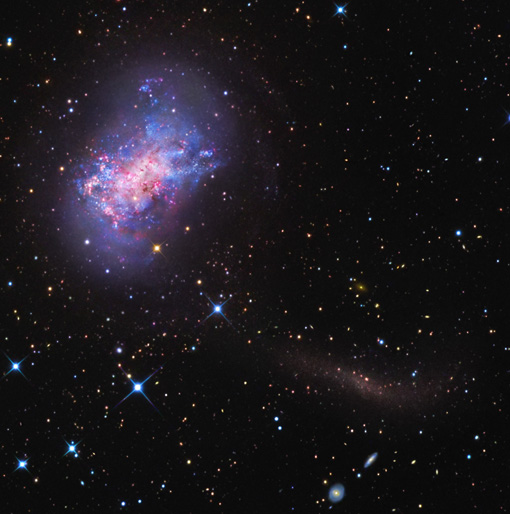|
|
MPIA Science Release 2012-02-09 |
|
| German version |
Watching a tiny galaxy grow
For the first time, astronomers have caught a so-called dwarf galaxy in the process of swallowing another, even smaller galaxy. Whether such mergers are important for the evolution of the tiniest galaxies has been the subject of debate among theoreticians. Now, thanks to research by two independent groups including MPIA researchers David Martínez-Delgado and Michelle Collins, there is empirical evidence that such mergers occur. The analyses draw on deep images from modestly sized telescopes, in an example for successful collaboration between amateur and professional astronomers.
 |
Figure 1: The dwarf galaxy NGC 4449 (top left) and the even tinier galaxy it is about to gobble up (bottom right). Image credit: R. Jay GaBany (Blackbird Observatory) in collaboration with David Martínez-Delgado (MPIA) Minimal image credit: R. J. GaBany (BBO)/D. Martínez-Delgado (MPIA) [Larger version for download] |
| Contact | Background information | Links | Questions and Answers | Images |
In the widely accepted hierarchical model of galaxy evolution, much of galactic growth involves acts of cannibalism and large-scale mergers: pre-existing, smaller galaxies successively coalesce into larger pieces until large galaxies, the size of the Milky Way or even bigger, form. But before galaxies and their stars can merge, stars have to form in the first place.
This is thought to happen by gas gathering to form denser regions under the influence of its own gravity; once a critical density is reached, stars are born. Conceivably, the smallest galaxies, so-called dwarf galaxies, might form in this way directly, and might grow bigger as they incorporate new gas from their surroundings, processing the new material into stars. In this way, there would be growth without the need for mergers. And indeed, until now, no such mergers had been observed.
Now, two independent groups of researchers, one led by David Martínez-Delgado of the Max Planck Institute for Astronomy (MPIA), the other by Michael Rich of UCLA, have identified the first confirmed example for a galaxy merger between very small galaxies. They found convincing evidence that a small companion of the dwarf galaxy NGC 4449 in the constellation Canes Venatici, first identified in 2007, is indeed another, smaller dwarf galaxy in the process of being disrupted by its larger neighbour – prior to being swallowed up.
Martínez-Delgado says: "A number of models predict that dwarfs should eat dwarfs. But this is the first clear example of such a feast that has been actually observed: We've found a key piece of the puzzle of galaxy evolution. Also, the fact that NGC 4449 is quite close to us shows that processes like this are still happening. They need to be taken into account if we want to describe our cosmic neighbourhood."
MPIA's Michelle Collins, who worked with Michael Rich on analyzing the dwarf galaxy's shape, adds: "Knowing what a half-digested dwarf galaxy looks like should help us find additional examples of dwarfs eating dwarfs. Finding a fair number of examples should put our models of the first stages of galactic growth on a firm footing – or show what we're missing."
Mass estimates for the distorted dwarf suggest that it contains significant amounts of Dark Matter, which does not emit light and only interacts with ordinary, atomic matter via gravity. If so, then this pairing could be a rare glimpse of a "stealth merger" – a galaxy's merger with a low-brightness object that is difficult to observe directly, yet, due to its high mass, can have a major influence on the receiving galaxy's shape, size and dynamics.
Both groups' examinations of the smaller dwarf galaxy's basic properties was performed with modest-scale instruments in cooperation with amateur astronomers: Rich et al. used the Saturn Lodge 0.7m telescope on the grounds of the Polaris Observatory Association for observations May-June 2011, while Martínez-Delgado et al. used Jay GaBany's 0.5 m telescope at Black Bird Observatory for observations between April 2010 and January 2011. Martínez-Delgado et al. followed up with detailed observations using the SUBARU telescope on Hawai'i in January 2011, obtaining images in which the smaller galaxy's haze is resolved into separate stars.
The paper by Rich et al. will appear in the February 9, 2012 issue of the journal Nature. The paper by Martínez-Delgado et al. is in press at the Astrophysical Journal Letters.
| top |
Contact
David Martínez-Delgado (Science contact)
Max Planck Institute for Astronomy
Phone: (+49|0) 6221 – 528 455
Email: delgado@mpia.de
Michelle Collins (Science contact)
Max Planck Institute for Astronomy
Phone: (+49|0) 6221 – 528 360
Email: collins@mpia.de
Markus Pössel (Public relations)
Max Planck Institute for Astronomy
Phone: (+49|0) 6221 – 528 261
Email: pr@mpia.de
| top |
Background information
The article by Rich et al. is "A tidally distorted dwarf galaxy near NGC 4449" in the February 9, 2012 issue of Nature. The authors are R. Michael Rich (UCLA and Polaris Observatory Association), Michelle L. M. Collins (Max Planck Institute for Astronomy), C. M. Black (UCLA), Francis A. Longstaff (Polaris Observatory Association and UCLA), Andreas Koch (Zentrum für Astronomie, Heidelberg University), Andrew Benson (Caltech), and David B. Reitzel (UCLA and Griffith Observatory).
The article by Martínez-Delgado et al. is "Dwarfs gobbling dwarfs: A stellar tidal stream around NGC 4449 and hierarchical galaxy formation on small scales", Astrophysical Journal Letters, in press. The authors are David Martínez-Delgado (Max Planck Institute for Astronomy), Aaron J. Romanowsky (University of California Observatories), R. Jay GaBany (Blackbird Observatory), Francesca Annibali (Osservatorio Astronomico di Bologna), Jacob A. Arnold (University of California Observatories), Jürgen Fliri (Observatoire de Paris), Stefano Zibetti (Niels Bohr Institute, University of Copenhagen), Roeland P. van der Marel (Space Telescope Science Institute, Baltimore), Hans-Walter Rix (Max Planck Institute for Astronomy), Taylor S. Chonis (University of Texas at Austin), Julio A. Carballo-Bello (Instituto de Astrofisica de Canarias, Tenerife), Alessandra Aloisi (Space Telescope Science Institute), Andrea V. Macciò (Max Planck Institute for Astronomy), J. Gallego-Laborda (Fosca Nit Observatory), Jean P. Brodie (University of California Observatories), and Michael R. Merrifield (University of Nottingham).
David Martínez-Delgado's research at MPIA is funded by the Alexander von Humboldt Foundation.
| top |
- Links
- Rich et al. paper
- Martínez-Delgado paper
- Image and information on cosmotography.com
- Background information on cosmotography.com
| top |
Questions and Answers
What is new/significant about this result?
When NGC 4449's smaller companion was first discovered (Karachentsev, Karachentseva & Huchtmeier 2007) as part of a search for nearby dwarf galaxies, the researchers involved speculated it might be a dwarf distorted during the merger of larger galaxies, or a dwarf about to be captured. The new, thorough analyses by the two groups Rich et al. and Delgado-Martínez et al. confirm that this is indeed a dwarf about to be gobbled up by the larger dwarf galaxy NGC 4449.
This is the first clear evidence for dwarf-dwarf-mergers. Previously, such mergers had already been under discussion as a mechanism for the formation of existing dwarf galaxies; however, it was also conceivable that such galaxies formed directly out of pristine gas. They could then continue to grow by incorporating gas from their surroundings, forming new stars in the process.
The fact that the dwarf pair is comparatively close to Earth, at a distance of about 12 million light-years, shows that such mergers are a necessary ingredient if we want to describe our cosmic neighbourhood (the "local universe").
What telescopes/instruments were used?
Both groups used advanced amateur-class telescopes for characterizing the distorted dwarf galaxy: the Rich group the Saturn Lodge 0.7 m telescope (Centurion 28 inch) funded and implemented by Rich and Longstaff and located at the site of the Polaris Observatory Association, which was used for deep imaging between 29 May 2011 and 1 June 2011 in the course of its commissioning; the Martínez-Delgado group used R. Jay GaBany's 0.5 m Ritchey-Chretien telescope at Blackbird Observatory in Alder Springs, California, for observations during April-June 2010 and in January 2011. Martínez-Delgado and his team followed up with the SUBARU Telescope, the flagship telescope of the National Astronomical Observatory of Japan, a reflecting telescope whose main mirror is 8,2 metres in diameter, using the telescope's Suprime camera, on January 5, 2011.
| top |
| Figure 2: The dwarf galaxy NGC 4449 (top left) and the even tinier galaxy it is about to gobble up (bottom right). Inset: Close-up of the tiny galaxy about to be gobbled up by NGC 4449. In this image taken with the SUBARU telescope, the galaxy is resolved into individual stars. Image credit: R. Jay GaBany (Blackbird Observatory) in collaboration with David Martinez-Delgado (MPIA). Inset image: R. Jay GaBany (Blackbird Observatory), Aaron Romanowsky (UCSC) and Jacob Arnold (UCSC) in collaboration with David Martinez-Delgado (MPIA) and the National Astronomical Observatory of Japan (NAOJ). Minimal image credit: GaBany (BBO)/Martínez-Delgado (MPIA)/UCSC/NAOJ [Larger version for download] |
 |
|
 |
Figure 3: Close-up of the tiny galaxy about to be gobbled up by NGC 4449. In this image taken with the SUBARU telescope, the galaxy is resolved into individual stars. Image credit: R. Jay GaBany (Blackbird Observatory), Aaron Romanowsky (UCSC) and Jacob Arnold (UCSC) in collaboration with David Martínez-Delgado (MPIA) and the National Astronomical Observatory of Japan (NAOJ). Minimal image credit: GaBany (BBO)/UCSC/NAOJ/Martínez-Delgado (MPIA) [Larger version for download] |
|
| top |
Images
 |
PR_120209_1.jpg | JPG | RGB | 510 x 514 | 86 KB |
| PR_120209_1gr.jpg | JPG | RGB | 1000 x 1007 | 250 KB | |
| PR_120209_1hr.jpg | JPG | RGB | 2804 x 2823 | 3,3 MB | |
 |
PR_120209_2.jpg | JPG | RGB | 510 x 514 | 98 KB |
| PR_120209_2gr.jpg | JPG | RGB | 1000 x 1007 | 279 KB | |
| PR_120209_2hr.jpg | JPG | RGB | 2804 x 2823 | 2,9 MB | |
 |
PR_120209_3.jpg | JPG | RGB | 510 x 617 | 123 KB |
| PR_120209_3gr.jpg | JPG | RGB | 1000 x 1209 | 307 KB | |